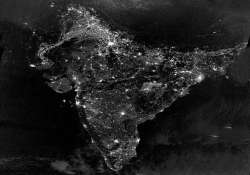How India looked from space on Diwali night: Nasa pic
Washington, Dec 6 : NASA, the national space agency of the US, today released a black and white satellite imagery of India this Diwali night, cautioning people against the fake image in circulation on the

Washington, Dec 6 : NASA, the national space agency of the US, today released a black and white satellite imagery of India this Diwali night, cautioning people against the fake image in circulation on the social media.
“On November 12, 2012, the Visible Infrared Imaging Radiometer Suite (VIIRS) on the Suomi NPP satellite captured this nighttime view of southern Asia,” NASA said releasing a picture of India on this Diwali night.
“The image is based on data collected by the VIIRS ‘day- night band', which detects light in a range of wavelengths from green to near-infrared. The image has been brightened to make the city lights easier to distinguish,” it said.
NASA said most of the bright areas in the imagery released by it are cities and towns in India, the country with the world's largest Hindu population.
“India is home to more than 1.2 billion people and has 30 cities with populations over 1 million. (For comparison, China has 62 cities with more than 1 million residents and the United States has 9),” it said.
Cities in Bangladesh, Nepal, and Pakistan are also visible near the edges of the image.
“An image that claims to show the region lit for Diwali has been circulating on social media websites and the Internet in recent years. In fact, it does not show what it claims. That image, based on data from the Operational Linescan System flown on US Defense Meteorological Satellite Program (DMSP) satellites, is a color-composite created in 2003 by NOAA scientist Chris Elvidge to highlight population growth over time,” NASA said.
“In that image, white areas show city lights that were visible prior to 1992, while blue, green, and red shades indicate city lights that became visible in 1992, 1998, and 2003 respectively,” it said.
“On November 12, 2012, the Visible Infrared Imaging Radiometer Suite (VIIRS) on the Suomi NPP satellite captured this nighttime view of southern Asia,” NASA said releasing a picture of India on this Diwali night.
“The image is based on data collected by the VIIRS ‘day- night band', which detects light in a range of wavelengths from green to near-infrared. The image has been brightened to make the city lights easier to distinguish,” it said.
NASA said most of the bright areas in the imagery released by it are cities and towns in India, the country with the world's largest Hindu population.
“India is home to more than 1.2 billion people and has 30 cities with populations over 1 million. (For comparison, China has 62 cities with more than 1 million residents and the United States has 9),” it said.
Cities in Bangladesh, Nepal, and Pakistan are also visible near the edges of the image.
“An image that claims to show the region lit for Diwali has been circulating on social media websites and the Internet in recent years. In fact, it does not show what it claims. That image, based on data from the Operational Linescan System flown on US Defense Meteorological Satellite Program (DMSP) satellites, is a color-composite created in 2003 by NOAA scientist Chris Elvidge to highlight population growth over time,” NASA said.
“In that image, white areas show city lights that were visible prior to 1992, while blue, green, and red shades indicate city lights that became visible in 1992, 1998, and 2003 respectively,” it said.